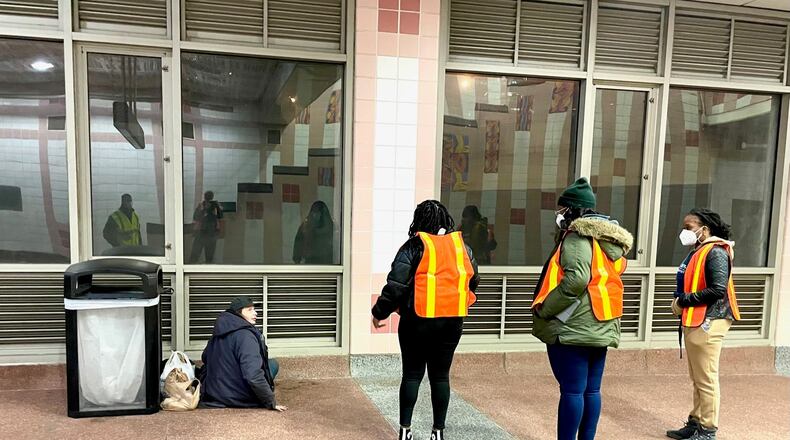You might say Jerry Young is the face of homelessness in Atlanta. And it’s not pretty.
Young smiled easily as he was interviewed by volunteers Monday night taking the city’s annual homeless census. When he spoke, it was evident he had no front teeth.
“I had my teeth kicked out downtown,” he said. “I got jumped by Grady Hospital. We were sleeping.”
By “we,” Young means he and his wife of nine years. The Missouri native said they spent six-plus years in motels and the last two living outside in Atlanta. They avoid shelters and prefer to stay under a bridge on the walking path near Ga. 400. It’s relatively isolated there.
The streets downtown were too mean. “That’s why we moved up here,” Young said. “People are nicer.”
Young was sitting, facing a wall by a garbage can at MARTA’s Buckhead Station near Lenox Square. He was charging his cellphone and awaiting a call from his wife when approached by volunteers performing the point-in-time homeless count, an annual civic reckoning of an intractable problem.
The count is a measuring stick for agencies fighting homelessness to gauge their progress. For years, it was good. There are, according to the counts, half as many homeless people on Atlanta’s streets as a decade ago — 5,987 in 2011 versus 3,240 in 2020. However, 2020 saw a 30% annual increase in the “unsheltered,” those who for some reason decide to sleep outside on a January night. That number jumped to 939 in 2020, the category’s highest count since 2015.
And then COVID hit, causing agencies including Partners for Home, the city’s nonprofit that oversees housing homeless people, to scramble. Cathryn Marchman, its executive director, told me they closed eight homeless encampments to slow the virus’ spread and placed 246 people in an underused hotel near the old Turner Field. Ultimately, 195 moved to permanent housing.
Credit: Bill Torpy
Credit: Bill Torpy
“You’ll have some who say ‘No Thanks’ and move somewhere else that’s more visible,” Marchman said. She added that many who work with homeless people tell her, “I’m not seeing the regulars; I’m seeing lots of new faces and more people with mental illness.”
It certainly seems there are more encampments and homeless people wandering the streets. And those out there seem to be more broken, desperate and pitiful. Their enclaves are more pronounced. Their tents shabbier. There’s more trash strewn about.
It’s just so in your face. Monday night, there were some 25 tents in a parking lot off Decatur Street near Georgia State University. There were about 30 humans huddled in sleeping bags on the sidewalk outside the Gateway Center, the old city jail that serves as a homeless shelter. And about 25 tents lined up along Central Avenue across from the Fulton County Courthouse and within sight of the Georgia Capitol and Atlanta City Hall.
“There’s more than there ever was,” said Cathal Doyle, a director at the Central Night Shelter, which usually housed about 120 men each winter behind the Catholic Shrine. His shelter, which is volunteer-run, closed last year because of COVID and will reopen Feb. 2.
Tony Carter, who I spoke with at his tent along Central Avenue about midnight, said he had spoken with the homeless census takers and has entered programs to get him off the street. The 54-year-old Atlanta native said he’s been without a home eight months and sleeping in the present spot for about two. He said his kids want to take him in but his pride prevents that. He’s worked landscaping and restaurant jobs but worries his belongings will get stolen if he leaves them for too long.
“It’s gonna turn around; it’s got to,” he said.
What will it take to turn around? I asked.
“Me,” he said with a sad laugh. “It’s just me.”
Central Atlanta Progress, downtown’s business coalition, notes that the number of loitering people asked to leave properties downtown dropped from 45,400 in 2019 to 35,622 last year, no doubt due to there being fewer businesses open during that time. CAP’s “social impact director,” Tammy Hughes, said the agency is working to place people in housing (about 276 last year) or in shelters (about 1,300 last year, although one suspects some may have been counted several times).
Hughes said a key issue she is focused on is to get day shelters, where homeless people can get off the streets during daytime. They need to be smaller and spread out in the city, making them more manageable, she said, places “where you don’t just languish all day, you have to be productive.”
It’ll be a tough sell. Anything to do with homeless people brings out the NIMBY in even the most socially conscious communities.
Credit: Bill Torpy
Credit: Bill Torpy
A glimpse of the desperation could be seen in Kevin Schultz, who is 43 and originally from Philly. He said he’s a college grad and a vet, although he was dishonorably discharged. He was standing in a little settlement of campers along the old church across from the Capitol. He pointed to a sleeping bag on the sidewalk.
“That’s my wife,” he said. He said their tent had been stolen. A guy even tried to steal his bag of potato chips recently as he slept.
“There’s a lot of craziness out here,” Schultz said. “My wife doesn’t need to be sleeping out here. But, to be honest, none of them need to be out here.”
About the Author
Keep Reading
The Latest
Featured




